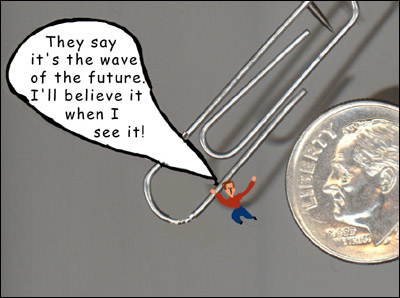Nanotalk:
Big issues from very small stuff

George Whitesides walks to the front of a full lecture hall in the Science Center. It is April 16, and the Mallinckrodt Professor of Chemistry is about to present “Nanoscience and Nanotechnolgy: What Is It?” Members of the audience have been murmuring about Whitesides’ dry sense of humor, their pads on their laps, pens poised. Clearly, the assembled expect an interesting evening from this speaker.
They will not be disappointed. No sooner has Whitesides been introduced than images begin flashing on a giant screen. He primes the crowd to think big by showing motors, airplanes, and computers – the stuff of yesterday’s techno-revolutions. When the internal combustion engine burst onto the scene, he notes, we traded our horses for automobiles. When the jet engine took to the skies, continents seemed to drift closer together as distance travel became a cakewalk. And the microchip brought computing power into everyone’s life, in one form or another.
Getting quickly down to the evening’s purpose, Whitesides asks, “Is nanotechnology as big as these discoveries?”
What is it, anyway?
Nanotechnology takes its name from the nanometer, which measures one-billionth of a meter long. To give a sense of such an inconceivably small object, you could place 100,000 nanoparticles across the width of a single strand of human hair.
Whitesides would have been glad to dramatize this fact by yanking a hair from his own head but, as the balding professor points out, he doesn’t have enough to pull it off. Suffice to say that nanoscience deals in the tiny – anything up to a few hundred atoms across. Think small virsuses, large molecules, that sort of thing.
Getting back to one of his central points, Whitesides reveals his not-surprising bias in favor of viewing nanoscience as a very big deal. “Nanoscience is a legitimate frontier,” he says.
Of geodesic domes and cell-sized wonders
Indeed, nanotechnology has already made history in the medical arena: The development of medicines such as penicillin and cholesterol-lowering lipitor are constructions on the nanoscale. Looking at medicines from the nanoscience perspective, Whitesides points out, we see “tools that manipulate biological nanomachines.” Those machines are, of course, the body’s cells.
The cell is itself the most wondrous of all nano-constructs. “I stand before you as a collection of cells,” proclaims Whitesides. He unabashedly admits that scientists have very little notion of how even the most basic cellular machines work, and humbly invites the audience to “look to biology for the source of astonishing nanostructures.”
But while nature has it all over humans in the realm of cool nano-motors and systems, scientists are not without their contributions.
Human-manipulated nanoparticles, for example, are used in medicine to detect metastatic tumors in the liver. Called magnetic resonance contrast enhancement agents, these particles are also used in clinical studies to identify breast cancer in its earlier stages.
On the genomics front, scientists drag DNA strands through specially engineered holes a mere nanometer wide. They hope to one day analyze DNA as it slides through these holes.
And then there’s the poster child of nanotechnology, the “bucky tube.” Also called carbon nanotubes, these super-small cylinders consist of hexagonal graphite molecules attached at the edges. They’re nicknamed after Buckminster Fuller, inventor of the geodesic dome, a structure widely hailed as the lightest, strongest, and most cost-efficient ever devised. Carbon nanotubes are in commercial use today. The auto industry is using plastics in which nanotubes are embedded. The bucky tubes render these plastics profoundly more resistant to temperature extremes than traditional plastics. They also eliminate the static electricity problems found in non-nanotube plastics.
Thanks to nanoscience, dense information storage is coming of age. More data stored in smaller spaces spells a new era for information technology and communications.
Big potential losses
But while all of this may sound like so much crowing about the good life brought on by technology, Whitesides pointed again and again to the potential minuses of nanoscience. He also warned the United States not to be complacent about its place in a rapidly changing nano-world.
While acknowledging that nanotechnology may bring about improved national security, for example, “we may also suffer a loss of privacy,” says Whitesides, “and the world may become more segregated economically and technologically.”
And while nano-discoveries are impressive, Whitesides says nanoscience is “not quite cooked yet” as a technological giant. “We need some more discoveries.”
Where will such discoveries most likely to take place? Don’t assume it’ll be the United States, cautions Whitesides. Japan’s and Western Europe’s investments in nanotech R&D are on par with the United States, and China is coming up quickly. “We don’t yet know how we will compete” in this ratcheted-up environment. “If we don’t figure this out,” he says, “the U.S. will lose a major competitive advantage.”
The country’s challenges seem daunting, especially when Whitesides points out that U.S. students are not given enough of a basic scientific education. As a result, countries like China and India are moving far ahead of the United States in technological literacy.
To turn the tide and cultivate a culture of continuing nano-brilliance, universities should play a role in helping the United States gain back the scientific ground it has lost. After all, says Whitesides, “much of our country’s wealth has come from technology.” Harvard and other institutions of higher learning should help increase the country’s scientific literacy by “giving students obligatory doses of technology and science. We have to help students understand how it all fits together. It’s a complex issue.”




